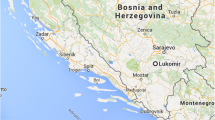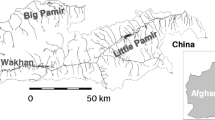Abstract
Ethnobotany of the Rama of Southeastern Nicaragua and Comparisons with Miskitu Plant Lore. The Rama are one of the three Amerindian groups of eastern Nicaragua. This is the first systematic study of Rama ethnobotany. A total of 249 plant species, in 190 genera and 78 families, were documented as useful. Included are 190 species used as medicinals, 80 as food plants, and 99 for other uses. The ethnobotanical lore of two distinct indigenous groups, the Rama and Miskitu, were compared. Out of 249 species used by the Rama, 171, or 69%, were used by both groups, and 78 unique species were used by the Rama. These results have important implications for the understanding of ethnobotany as they demonstrate how unrelated indigenous groups sharing the same ecosystem, though separated by some physical distance, can have significantly similar ethnobotanical lore.
Resumen
Etnobotánica de los Ramas del Oriente Nicaragüense y Comparasiones con el Saber Etnobotánico de los Miskitus. Los Ramas constituyen uno de los tres grupos Amerindios del oriente Nicaragüense. Este es el primer studio sistemático de la etnobotánica Rama. Se documentó un total de 249 especies de plantas útiles en 190 géneros y 78 familias. Incluyendo 190 especies medicinales, 80 especies alimenticias y 99 especies para usos auxiliares. La erudición etnobotánica de los Ramas y los Miskitus fueron comparados. Un total de 171 de 249 especies documentadas son usados por ambos grupos y 78 especies solo por los Ramas. Estos resultados tienen implicaciones importantes para el entendimiento de la etnobotánica porque demuestran que grupos sin parentesco alguno que comparten el mismo ecosistema aunque separados por cierta distancia pueden tener una similitud significativa en la erudición etnobotánica.

Similar content being viewed by others
Literature Cited
Barrett, B. 1994. Medicinal Plants of Nicaragua’s Atlantic Coast. Economic Botany 48:8–20.
Bell, C. N. 1989. Tangweera: Life and Adventures among Gentle Savages. University of Texas Press, Austin. (Originally published in 1899).
Brady, N. C. 1990. The Nature and Properties of Soils. Macmillan Publishing Company, New York.
Bridson, G. D. R. 1991. Botanico-Periodicum-Huntianum/Suplementum. Allen Press, Inc., Lawrence, Kansas.
Brummitt, R. K., and C. E. Powell, eds. 1992. Authors of Plant Names. Whitstable Litho, Ltd., Whitstable, Hent, U.K.
Chazdon, R. L., and F. G. Coe. 1999. Ethnobotany of Woody Species in Second-Growth, Old-Growth, and Selectively Logged Forests of Northeastern Costa Rica. Conservation Biology 13:1312–1322.
CIDCA (Centro de Investigación y Documentación de la Costa Atlántica). 1986. Diccionario Elemental: Miskito-Español/Español-Miskito. Editado e Impreso en MIDINRA, Managua, Nicaragua.
——— 1987. Diccionario Elemental Rama. University of Oregon, Eugene.
——— 1989. Diccionario Elemental del Ulwa: Sumu Meridional. Centro de Ciencia Cognitiva, Instituto Tecnológico de Massachusetts, Cambridge.
Coe, F. G. 1994. Ethnobotany of the Garífuna of Eastern Nicaragua. Ph.D. Dissertation (Botany), University of Connecticut, Storrs.
——— and G. J. Anderson. 1996a. Ethnobotany of the Garífuna of Eastern Nicaragua. Economic Botany 50:71–107.
——— and G. J. Anderson. 1996b. Screening of Medicinal Plants Used by the Garífuna of Eastern Nicaragua for Bioactive Compounds. Journal of Ethnopharmacology 53:29–50.
——— and G. J. Anderson. 1997. Ethnobotany of the Miskitu of Eastern Nicaragua. Journal of Ethnobiology 17:171–214.
——— and G. J. Anderson. 1999. Ethnobotany of the Sumu (Ulwa) of Southeastern Nicaragua and Comparisons with Miskitu Plant Lore. Economic Botany 53(4):363–386.
——— and G. J. Anderson. 2005. Snakebite Ethnopharmacopoeia of Eastern Nicaragua. Journal of Ethnopharmacology 96:303–323.
Collins, S., X. Martins, A. Mitchell, A. Teshome, and J. T. Arnason. 2006. Quantitative Ethnobotany of Two East Timorese Cultures. Economic Botany 60:347–361.
Conzemius, E. 1927. Die Rama Indianer von Nicaragua. Zeitschrift für Ethnologie 59:291–362.
——— 1932. Ethnographical Survey of the Miskito and Sumu Indians of Honduras and Nicaragua. Bureau of American Ethnology Bulletin No. 106. U.S. Government Printing Office, Washington, D.C.
Cronquist, A. 1981. An Integrated System of Classification of Flowering Plants. Columbia University Press, New York.
Davidse, G., M. Sousa S., and A. O. Chater, eds. 1995. Flora Mesoamericana. Vol. 1: Psilotaceae a Salviniaceae. Universidad Nacional Autónoma de México, Cuidad Universitaria, México, D.F.
Dennis, P. A. 1988. Herbal Medicine among the Miskito of Eastern Nicaragua. Economic Botany 42:16–28.
Guerrero, J. N., and L. Soriano de Guerrero. 1985. Diccionario Nicaragüense: Geográfico e Histórico. Editorial Somarriba, Masaya, Nicaragua.
Hale, C., and E. T. Gordon. 1987. Costeño Demography: Historical and Contemporary Demography of Nicaragua’s Atlantic Coast. Pages 7–31 in CIDCA, ed, Ethnic Groups and the Nation State: The Case of the Atlantic Coast in Nicaragua. University of Stockholm, Stockholm, Sweden.
Herlihy, P. H. 1997. Central American Indian Peoples and Lands Today. Pages 215–240 in G. Coates, ed. Central America: A Natural and Cultural History. Yale University Press, New Haven, Connecticut.
Incer, J. 1975. Geografía Ilustrada de Nicaragua. Editora y Distribuidora, Nicaragüense, S. A., Managua, Nicaragua.
——— 1985. Toponomías Indígenas de Nicaragua. Libro Libre, San José, Costa Rica.
Loveland, F. O. 1975a. Order and Disorder in Rama Indian Cosmology: Dialectical Aspects of Natural Symbols among the Rama Indians of Eastern Nicaragua. Ph.D. Dissertation, Duke University.
——— 1975b. Snakebite Cure among the Rama Indians of Nicaragua. Pages 81–102 in H. Haley and F. Grollig, eds. Medical Anthropology. Mouton, The Hague, The Netherlands.
——— 1976. Tapirs and Manatees: Cosmological Categories and Social Process among Rama Indians of Eastern Nicaragua. Pages 67–82 in M. W. Helms and F. O. Loveland, eds. Frontier Adaptations in Lower Central America. Institute for the Study of Human Issues, Philadelphia, Pennsylvania.
——— 1986. Jaguar Metaphor of Social Control and Authority in Rama Indian Myth. In E. Magaña and P. Mason, eds. Myth and the Imaginary in the New World. FORIS Publications, Providence, Rhode Island.
Nietschmann, B. Q. 1973. Between Land and Water: The Subsistence Ecology of the Miskito Indians, Eastern Nicaragua. Seminar Press, New York.
——— and J. Nietschmann. 1974. Cambio y Continuidad: Los Indígenas Ramas de Nicaragua. America Indígena 4:905–917.
Roberts, O. W. 1827. Narrative of Voyages and Excursions on the East Coast and the Interior of Central America. 1965 reprint, a facsimile of the 1827 edition. University of Florida Press, Gainesville.
Shepard, Jr., G. H. 2004. A Sensory Ecology of Medicinal Plant Therapy in Two Amazonian Societies. American Anthropologist 106:252–266.
Smutko, G. 1985. La Mosquitia: Historia y Cultura de la Costa Atlántica. Editorial La Ocarina, Managua, Nicaragua.
Stafleu, F. A., and R. S. Cowan. 1976–1988. Taxonomic Literature. 2nd edition. W. Junk, The Hague.
——— and E. A. Mennega. 1992–2000. Taxonomic Literature. 2nd edition. Koeltz Scientific Books, Supplement I–VII.
Stevens, W. D., C. Ulloa, A. Pool, and O. M. Montiel, eds. 2001. Flora de Nicaragua. Tomo I–III. Missouri Botanical Garden Press, St. Louis.
Stone, D. Z. 1977. Pre-Columbian Man in Costa Rica. Peabody Museum Press, Cambridge, Massachusetts.
Taylor, B. W. 1959. Ecological Land Use Surveys in Nicaragua. Vols. 1–2. Editorial Alemana, Managua, Nicaragua.
Vandermeer, J., N. Zamora, K. Yih, and D. Boucher. 1990. Regeneración Inicial en una Selva Tropical en la Costa Caribeña de Nicaragua Después del Huracán Juana. Revista Biología Tropical 38:347–359.
Wlliamson, D., J. Avilés, and M. McLean. 1993. Aspectos Generales de las Communidades Sumus de la RAAN. Wani 14:18–27.
Acknowledgments
This study was partially supported by grants from the National Science Foundation, the University of Connecticut Research Foundation, and the Department of Ecology and Evolutionary Biology. I am grateful to the Rama people for welcoming me into their homes and sharing their ethnobotanical knowledge. The field assistance of Basilio Benjamin, Harry Simmons, Jr., and Rodney Martin is appreciated. I thank the staffs of CIDCA (Centro de Investigación y Documentación de la Costa Atlantica) and FADCANIC (Fundación Para la Autonomía y Desarrollo de la Costa Atlántica de Nicaragua). Many specialists provided assistance in the identification of vouchers: William D’Arcy* (MO), Daniel Austin (FAU), Rupert Barnebyt* (NY), Gerrit Davidse (MO), James Grimes (NY), Helen Kennedy (UBC), Ronald Leisner (MO), Michael Nee (NY), Amy Pool (MO), Velva Rudd* (SFV), Warren D. Stevens (MO), and Charlotte M. Taylor (MO). I thank Virge Kask for help with the figure, tables, and appendix.
This paper is dedicated to Bernard Q. Nietschmann*, who fought to preserve the culture, natural resources, and the rights of the indigenous groups of eastern Nicaragua.
*Deceased
Author information
Authors and Affiliations
Corresponding author
Appendix. Rama plants and their uses
Appendix. Rama plants and their uses
Rights and permissions
About this article
Cite this article
Coe, F.G. Ethnobotany of the Rama of Southeastern Nicaragua and Comparisons with Miskitu Plant Lore1 . Econ Bot 62, 40–59 (2008). https://doi.org/10.1007/s12231-008-9006-y
Received:
Accepted:
Published:
Issue Date:
DOI: https://doi.org/10.1007/s12231-008-9006-y




